
Market up despite new crop arrivals: good demand from stockist and millers
Delhi
Due to light rain and bad weather in some chana-producing areas of Rajasthan, the buying activity of pulse mills and stockists increased last week, resulting in an increase in prices. Delhi prices registered an increase of Rs. 50/75 per quintal with the Madhya Pradesh line reaching Rs. 5,150/5,075 and the Rajasthan line Rs. 5,250 per quintal
Port
An improved demand of imported chana was seen at the ports. Tanzania and Sudan prices registered an improvement of Rs 25/50 per quintal and were traded at Rs. 4,600 and Rs. 5100 per quintal, respectively.
Rajasthan
New crops started arriving in some markets of Rajasthan and demand from millers and stockists improved. An increase of Rs 50/75 per quintal was registered in most of the market yards. By the weekend, Jaipur traded at Rs. 5,100/5,150, Bikaner Rs. 5,000, Kishangarh Rs. 4,500/4,700 and Kekri Rs. 4,600/4,725 per quintal.
Madhya Pradesh
Due to better demand, Madhya Pradesh prices also improved by Rs. 50. The price of Indore Chana was Rs. 5,050/5,100, Katni Rs. 5,075/5,125, Ashoknagar Rs. 4,800/4,850, Ganjbasoda Rs. 4,200/4700, Pipariya Rs. 4,200/4,811, Sagar Rs. 4,400/4,850 and Damoh Rs. 4,500/4,750 per quintal.
Maharashtra
A strong increase in arrivals was seen in Maharashtra, where prices registered an improvement of Rs 50 per quintal due to increased buying by the stockists and millers. At the weekend, Latur prices were Rs. 4,750/4,890, Akola Rs. 4,900/4,975, Nagpur Rs. 4,975 Dudhni Rs. 4,500/4,700, Jalgaon Rs. 4,750/4,850 and Ahmednagar Rs. 4,700/4,900 per quintal.
Karnataka
An increase of Rs. 50/100 per quintal was recorded and by the weekend Gulbarga traded at Rs. 4,600/4,800, Raichur Rs. 4,136/4,727, Bidar Rs. 4,300/4,736, Talikot Rs. 4,621/4,746, Hubli Rs. 4,450/4,609 and Gadag Rs. 4,526/5,056 per quintal.
Other
Kanpur prices registered an improvement of Rs 50 per quintal this week due to the support of all-round bullishness and increased buying. With this improvement, the prices rose to Rs 5225/5300 per quintal over the weekend. Raipur prices also saw an increase of Rs. 100, bringing them up to Rs. 5,125/5,150 per quintal
Chana Dal
Last week, there was sporadic buying in chana dal and an improvement of Rs 25/50 per quintal was seen in prices. Delhi traded at Rs. 5,800/6,000, Bhatpara Rs. 5,700/5,950, Kanpur Rs. 5,750/5,800, Bidar Rs. 5,900/6,000, Indore Rs. 6,000 and Jalgaon reached Rs. 5,850 per quintal.
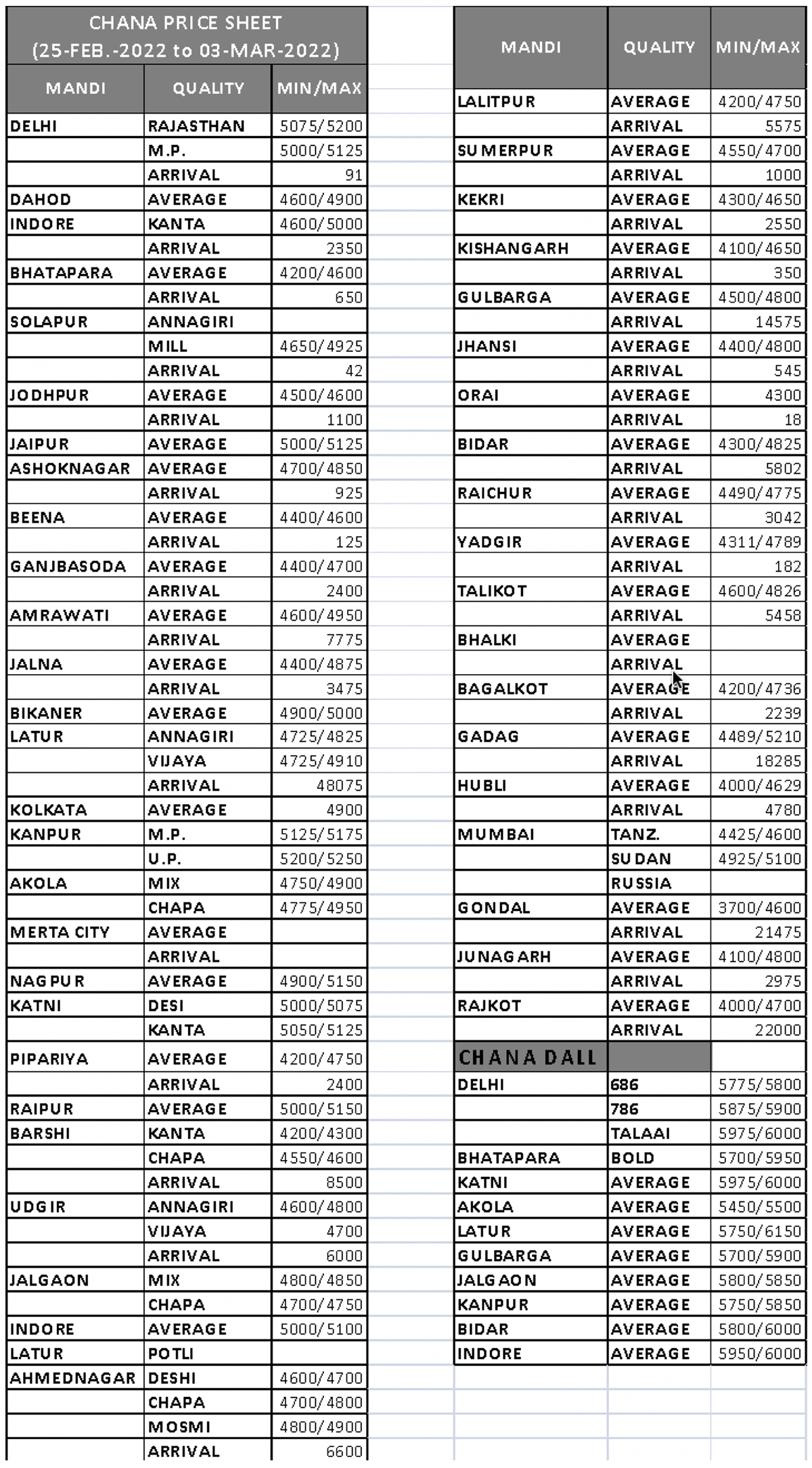
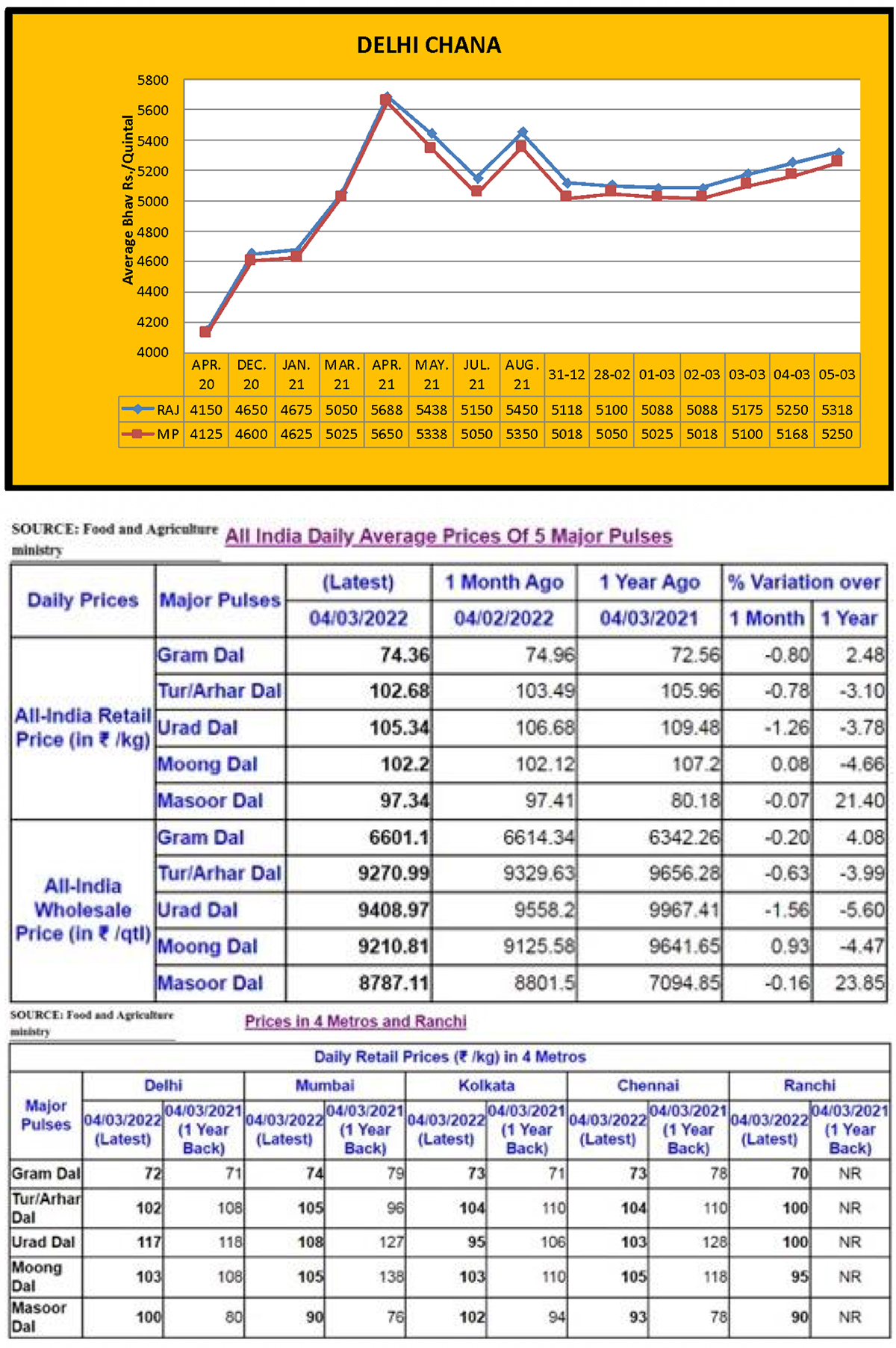
Good production of Chana due to more sowing and favourable weather
New Delhi. Government data shows that the sown area of chane, the most important pulse of the rabi season, increased by 4.57 lakh hectares this year, from 110.38 lakh hectares in 2020-21 to 114.95 lakh hectares. Although there was some decline in the sown area in Karnataka, Rajasthan, Andhra Pradesh and Haryana, the area increased significantly in Maharashtra, Madhya Pradesh, Gujarat, Uttar Pradesh and Telangana. The acreage in Maharashtra has even surpassed that of Madhya Pradesh: 26.60 lakh hectares compared to 25.05. The total area in Gujarat is 11 lakh hectares, 20.40 lakh in Rajasthan, 11.05 lakh in Karnataka, 5.95 lakh in Uttar Pradesh, 4.05 lakh in Andhra Pradesh and 1.30 lakh hectares in Telangana. The combined area in other states was close to 8.85 lakh hectares.
Throughout February, the weather and rainfall conditions were generally favourable for the crop in all major producing states. The Gujarat government has estimated production to reach a new record high of 24.90 lakh tons, jumping from 14.37 lakh tons last year.
Production is also expected to improve in other provinces. The Union Agriculture Ministry has estimated the total domestic production to reach an all-time high of 131.20 lakh tons, which is much higher than the fixed target of 106.60 lakh tons and last year's production of 119.10 lakh tons. The trade industry, however, estimates that production may be up to 10 lakh tons more than last year. Chana production was estimated at 80-85 lakh tons in the 2020-21 season, while this year it may reach 10 million.
The arrival of new gram crops has started in many wholesale mandis and supply is expected to pick up in all the major producing states after the Holi festival.
Pulse prices likely to improve
Despite the Corona crisis, the production of food grains in Bihar increased by 15.72 lakh tons
Patna. According to official data, despite the pandemic an increase of 15.72 lakh tons was recorded in grain production in Bihar during the 2020-21 season as compared to 2019-20. In the final estimate released by the state agriculture department, during the entire marketing season of 2020-21, the gross production of food grains in Bihar increased to 179.52 lakh tons as compared to 163.80 lakh tons in the 2019-20 season. The average yield rate also improved, from 25.62 quintal per hectare to 28.12 quintal per hectare. Despite a decrease in the sown area, rice production increased from 69.53 lakh tons in 2019-20 season to 73.93 lakh tons in the 2020-21 season due to an increase in yields. Similarly, the production of wheat jumped from 55.79 lakh tons in the 2019-20 season to 66.35 lakh tons in the 2020-21 season, thereby showing a significant increase of 10.56 lakh tons.
The production of pulses and oilseeds crops was also better in Bihar as compared to last year. According to the Agriculture Secretary, despite the pandemic and unfavourable weather conditions, agricultural production increased in Bihar.
Monsoon expected to be normal this year by private news agency
New Delhi. A private sector weather forecasting agency has predicted normal southwest monsoon conditions in the year 2022. If this prediction is correct, then India will receive good rains for the fourth year in a row. Monsoons generally start in the first week of June and continue through to September with the maximum rainfall occurring in July and August and benefiting the Kharif crops. A detailed release of the monsoon outlook is likely to be issued by the same agency in April.
In its initial monsoon forecast guidance for the year 2022, the agency said that the variation in temperature at the lower surface of the ocean in the equatorial Pacific is weakening, leading to the El-Nino and La Nina weather cycles remaining largely 'neutral'. As a result, the country is expected to receive neither above normal nor below normal rainfall during the southwest monsoon season.
A normal monsoon is considered when there is rainfall between 96 and 104 percent relative to the long period average. This year, the long-term average rainfall has been estimated as 880.6 mm. Normal monsoon conditions are integral to the good development of Kharif crops because about 60 percent of the agricultural area of the country is dependent on rain. Many crops, including paddy, soybean, groundnut, tuar, urad, mung, maize, jowar, bajra, ragi, cotton and sugarcane, are produced on a large scale in the Kharif season. The country receives 70 per cent of its rainfall during the southwest monsoon season and this helps in the sowing and development of Kharif crops.
The Union Agriculture Ministry has estimated the production of food grains at 3160.60 lakh tons in 2021-22, which is 53.20 lakh tons more than the production of 3107.40 lakh tons in the 2020-21 season. This includes production of rice, wheat, coarse anna and pulses. The production of oilseeds and sugarcane is also expected to increase.
Pulse exports from India improve
New Delhi. Although the exports of pulses from India are much lower than those of Canada, Australia, Myanmar and some African countries, average annual exports remain above 2 lakh tons. Due to an increase in domestic production, imports decreased significantly in 20/21.
According to data from the Agricultural and Processed Food Products Export Development Authority (APEDA), a subordinate agency of the Union Ministry of Commerce, from April to December 2020, nearly 2.15 lakh tons of pulses and split pulses were exported, while in the same period in the current financial year, exports were above reached 2.63 lakh tons.
According to the data, the export income of pulses increased by 17.66% in Rupees, from Rs. 1,534 crores to Rs. 1,805 crores, and 18.60% in USD to 24.30 million dollars.
Whole and split pulses are mainly exported from India to neighbouring Southeast Asian countries and the countries of the Gulf region while organic pulses are exported to America and the European Union.
Procurement of Rabi pulses in Andhra Pradesh gets green signal from Central government
Vijayawada. After a request from the Andhra Pradesh government, the Central government has implemented a Price Support Scheme in the state for the procurement of gram, urad and mung for the current 2021-22 Rabi season.
The procurement process will continue for the next 90 days from the date fixed for the purchase of these pulses by the state government and, during this period, 1,28,270 tons of gram, 91,475 tons of urad and 19,632 tons of mung have been approved
The Union Agriculture Ministry has asked its subordinate nodal agency to initiate discussions with the state government to fix the date for starting the procurement process of Rabi crops. Central agencies have been directed to verify the availability of storage before initiating the process of procurement as, under the guidelines of the Price Support Scheme, the state government has to make arrangements for safe storage from the procurement centres within the normal limits.
The nodal agencies have also been asked to clear the procured stock expeditiously and, at the same time, ensure procurement of only normal to average quality (FAQ) pulses.
The sown area of pulses in Andhra Pradesh is average this season and production is expected to be better as a result. The central government has fixed the MSP for gram at Rs. 5,230 per quintal, urad at Rs. 6,300 per quintal and mung at Rs. 7,275 per quintal
Arrival of new crops started in Madhya Pradesh and other states
Indore. In some parts of Madhya Pradesh, harvesting preparation for the early sown crop of pulses and wheat has also started and clear weather is expected to make for good progress.
The president of the Gross Grain Pulses Oilseeds Traders Association has said that arrivals are still less than the normal level in the mandis and the price of pulses are consequently not coming down. Stockists and millers are showing good interest in purchasing.


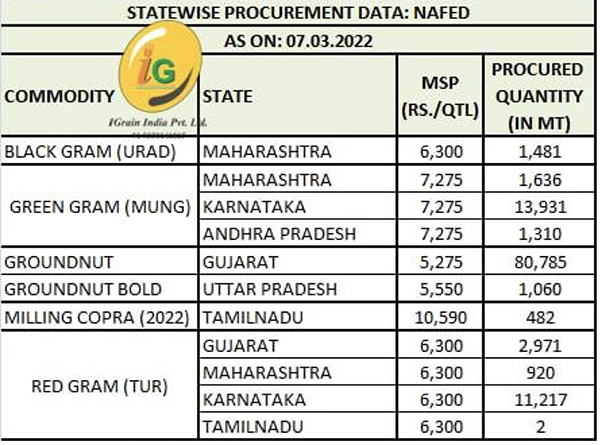
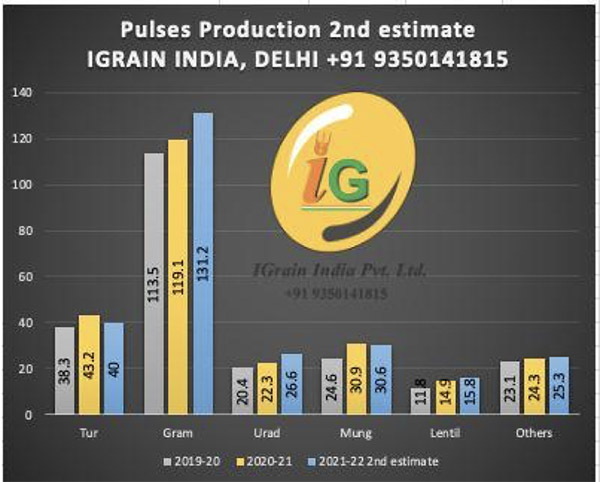
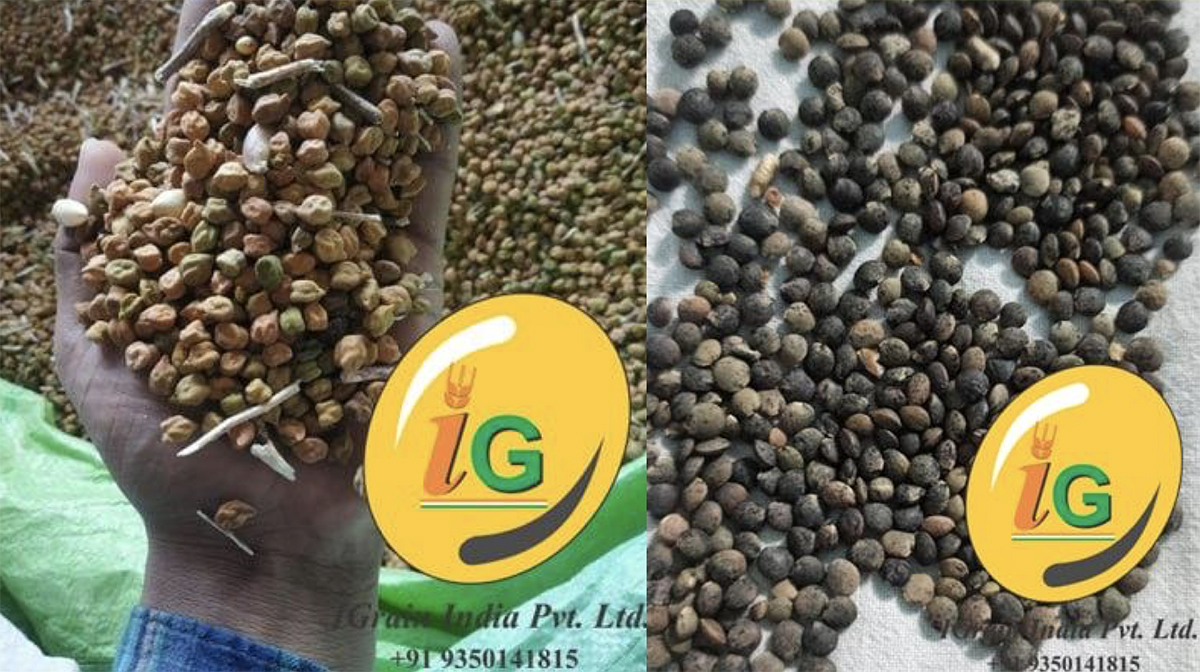
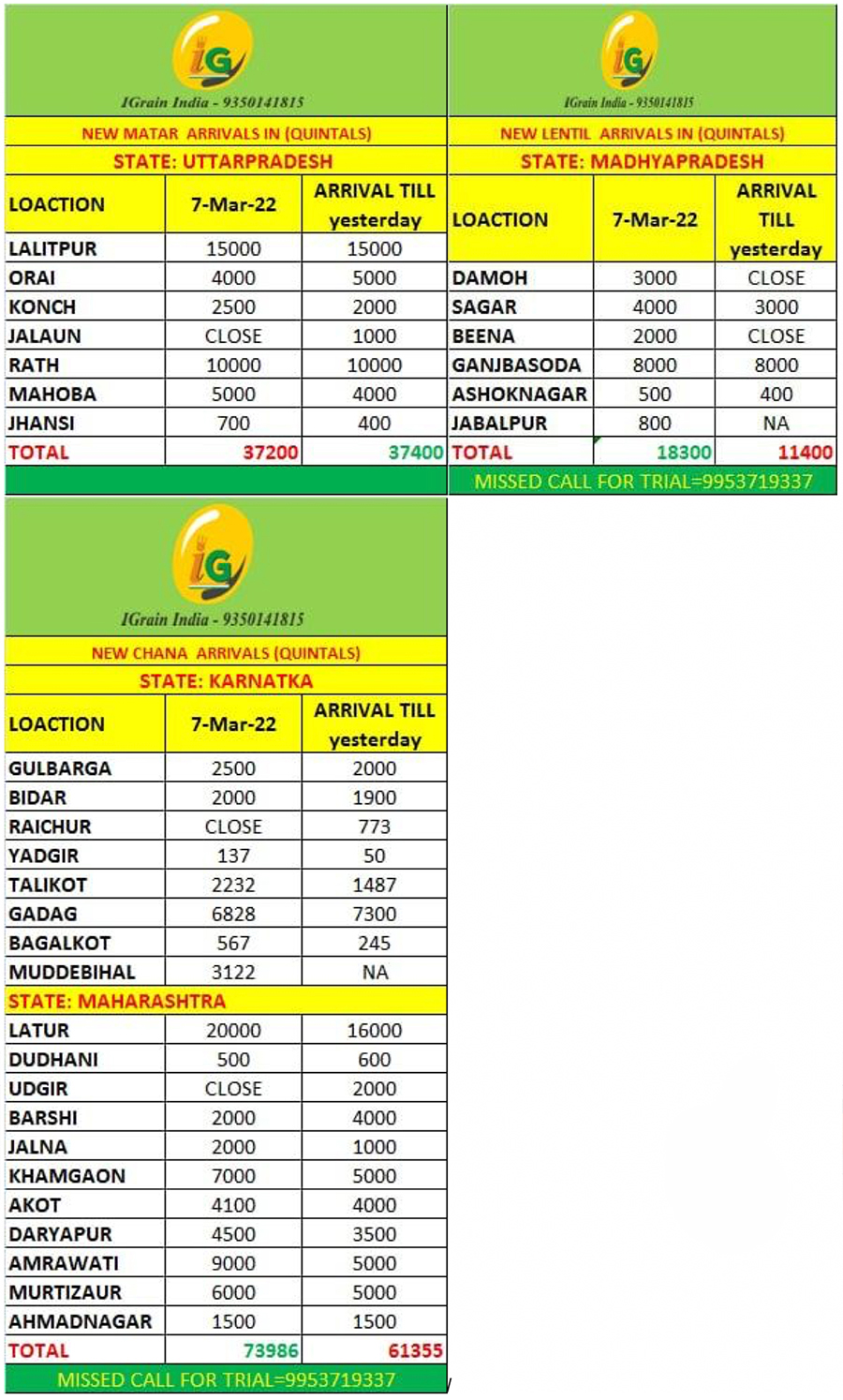
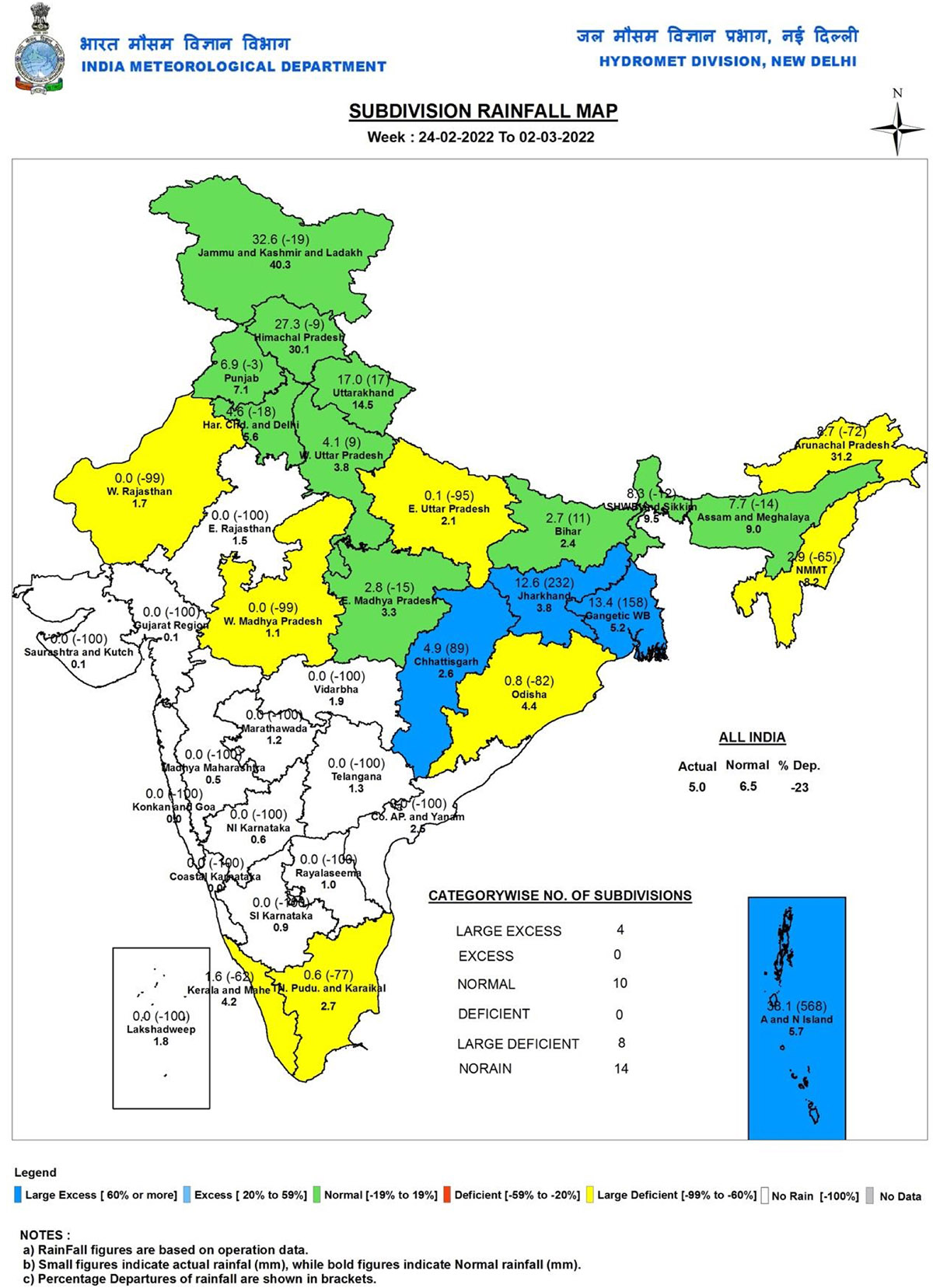
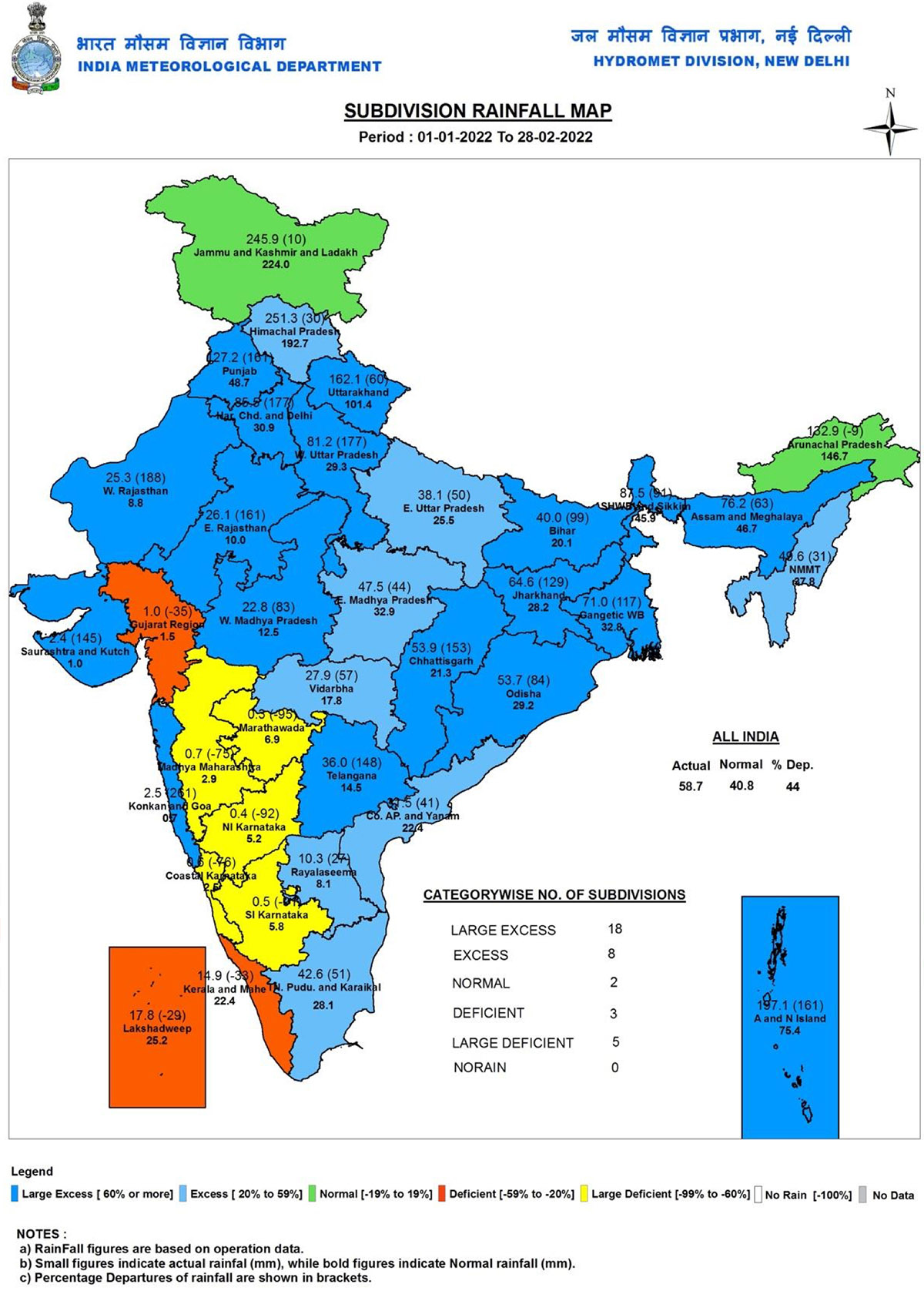
Abbreviations
Tuar/ Arhar: Pigeon Peas PP
Mung: Green Mung
Urad: Black Matpe
Chana: Gram, Desi Chickpea
Matar: Pea
Masur: Lentil
Besan: Gram Flour
Mandi: Market yard
Bhav: Prices
Dal/Daal: Processed Pulses (Directly for human consumption)
Rs: Indian Rupees (1$=Rs 76.91) 8 March, 22 at 01:08 PM IST
Rahul Chauhan
Director, IGrain India
igrainind@gmail.com
+91 9350141815
Twitter igrain_india

IGrain / Rahul Chauhan / India / Delhi / New Delhi / Port / Rajasthan / Madhya Pradesh / Maharashtra / Karnataka / Chana / Chick Peas / Desi Chick Peas / Black Matte / Mung / Red Kidney / Cowpea / Lentil / Pigeon Pea
Disclaimer: The opinions or views expressed in this publication are those of the authors or quoted persons. They do not purport to reflect the opinions or views of the Global Pulse Confederation or its members.